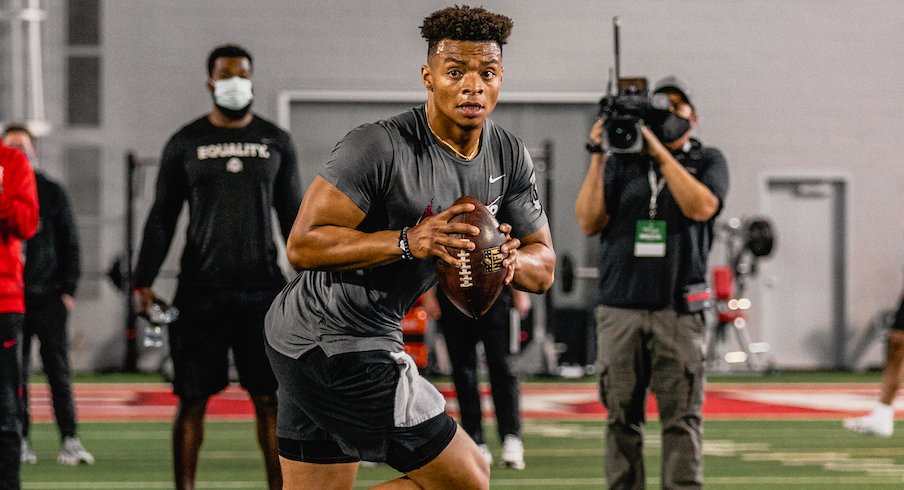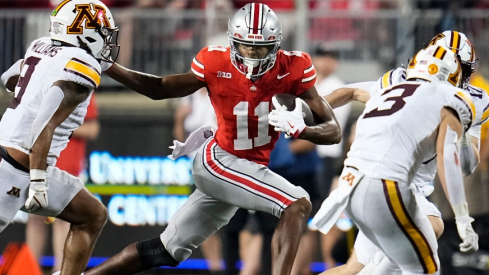In conversations about Justin Fields leading up to this year’s draft, one narrative has come up over and over again: Ohio State quarterbacks don’t succeed in the NFL.
From a historic perspective, it’s true. In the NFL’s modern era, no player who finished his college career at Ohio State has established himself as a long-term starting quarterback in the league. Mike Tomczak leads all Buckeyes with 73 career starts across 15 NFL seasons, but he never started a full 16-game season and threw more interceptions (106) than touchdowns (88).
Ohio State quarterbacks have had a poor track record in the NFL for decades, and the scarlet letter attached to the scarlet and gray at that position has only gotten bigger since the Washington Football Team released Dwayne Haskins in December, less than two years after drafting him with the 15th overall pick.
Should any of that be held against Fields as an NFL draft prospect? Probably not.
For one, Fields projects as a far better NFL prospect than just about every other Ohio State quarterback before him. He’s almost certainly going to be the highest-drafted Buckeye quarterback since Art Schlichter was the No. 4 overall pick in 1982, and Haskins is the only other Ohio State quarterback who’s been selected in the first round since. No other quarterback from the school has even been drafted in the first two rounds.
Though Troy Smith won a Heisman Trophy, Craig Krenzel and Cardale Jones won national championships and J.T. Barrett holds just about every career passing record at Ohio State, none of them were expected to be great NFL quarterbacks. Either way, their lack of success in the league shouldn’t be reason to predict that Fields – a more talented passer than any of them – will fail.
“In all honesty, I think I’m different than those guys,” Fields said last week when asked about the lack of NFL success of previous Ohio State quarterbacks. “I know my work ethic is unmatched, and just my dedication and my passion to wanting to be great is another level. So in terms of the past quarterbacks, I can’t control that, and the only similarity that me and those guys have is that we wore the same uniform. So if they want to say that, then that’s on them, and I’m gonna focus on myself and focus on continuing to get better in every aspect of the game.”
The offense Fields spent the past two years playing in is also different than that which most of his predecessors played in. Ryan Day is a former NFL quarterbacks coach, and he’s added more NFL concepts to Ohio State’s offense since he joined the Buckeyes as an offensive coordinator in 2017.
While some critics have harped on Fields mostly throwing the ball to his first read as a Buckeye, both Fields and Day attribute that to the fact that his first read was often open thanks to Chris Olave and Garrett Wilson. And Day bristles at the notion that his offense doesn’t prepare quarterbacks to play at the next level.
“I would argue that we have one of the more intricate offenses in the country. I take a lot of pride in that, coming from the NFL with multiple protections and calls and adjustments, full-field progressions,” Day said Friday during an appearance on 97.1 The Fan’s Morning Juice. “I hear some people saying that, and I wonder to myself, have you watched film, or are you just kind of repeating what other people have maybe said? And I don’t know where it all comes from. But if you just watch the Clemson game, the biggest game of the season for us, he gets to the fifth read twice in big spots and checks the ball down to Trey Sermon for big plays. The backside post that he throws to Chris Olave at midfield, I think it was in the third quarter, that was the fourth read in the progression on a backside post after he slid in the pocket and threw it 65 yards in the air. So there’s a lot that goes on in this offense.”
As seen below in the plays against Clemson that Day referenced above, Fields has shown the ability to work through progressions in order to find an open receiver when he has to:
If Haskins’ first two seasons in the league had been more successful, there’d likely be a different perception of Day and Ohio State’s current ability to develop NFL quarterbacks. But Haskins’ struggles so far as an NFL quarterback probably shouldn’t be pinned on the offensive system he played in collegiately. His tenure with the Washington Football Team ultimately ended because of his actions off the field, specifically multiple violations of the NFL’s COVID-19 protocols, and Washington coach Ron Rivera recently blamed Haskins’ struggles on not being committed enough to his craft.
Ask Day or just about anyone else at Ohio State about Fields, and they’ll tell you that’s the last thing an NFL team should have to worry about with him.
“He’s been one of the hardest-working guys. He’s one of the most competitively tough guys. And when he sets his mind to something, he gets it done,” Day said. “Whoever’s gonna draft Justin Fields is gonna get a great player, and a great person.”
On the field, Fields is also substantially more athletic than Haskins, which could make a big difference in a league where the most successful quarterbacks are increasingly those who are running threats that can make plays outside the pocket.
“It could. You look at the quarterback situation with Dwayne Haskins and coming out of that offense and all that,” ESPN’s Mel Kiper Jr., who ranks Fields as the second-best quarterback in the draft, said last month when asked if he thought the criticism of Fields as a draft prospect was related to the negative reputation of Ohio State quarterbacks in the NFL. “But he’s mobile. Dwayne was a pocket guy, is a pocket guy.”
Regardless of how previous Ohio State quarterbacks have fared, NFL Network draft analyst Daniel Jeremiah – a former NFL scout – said he doesn’t think that should factor into how Fields is evaluated as a prospect.
“You don’t do that. You scout everybody individually,” Jeremiah said while commentating Fields’ pro day workout on NFL Network last week. “We could go through the list and I can show you a position and a school where they’ve had good players and bad players. Everybody’s their own individual evaluation. I’ve never understood that argument.”
“In terms of the past quarterbacks, I can’t control that, and the only similarity that me and those guys have is that we wore the same uniform.”– Justin Fields on Ohio State quarterbacks' struggles in the NFL
Day has been known as a quarterback guru since he arrived at Ohio State, and the quarterbacks who have signed with the Buckeyes since he became their head coach shows that recruits are believing in that vision. Fields announced his transfer to Ohio State just one month after Day became head coach, the Buckeyes have since signed another five-star quarterback (Kyle McCord) and two four-star quarterbacks (C.J. Stroud and Jack Miller) and they already have a commitment from Quinn Ewers, the No. 1 overall prospect and quarterback in the class of 2022.
Even though Ohio State quarterbacks haven’t had much success in the NFL, McCord told Eleven Warriors before his enrollment that the program’s track record of developing NFL players was a big reason why he chose to become a Buckeye. And with Fields about to enter the league and Haskins getting a second chance with the Pittsburgh Steelers, McCord expects that track record to soon extend to the quarterback position, too.
“When you look on TV on Sundays, just seeing how many guys have come out of Ohio State and gone on to have success in the NFL is ridiculous,” McCord said in December. “There’s been success at every position, but quarterback seems to be lacking a little bit. I’m confident that Dwayne will turn it around once he gets another opportunity, and then Justin will dominate once he gets there. And hopefully I can just kind of build on the legacy.”
If Fields doesn’t succeed in the NFL, the stigma about Ohio State quarterbacks in the league will only grow stronger, and eventually that could hurt Day and the Buckeyes on the recruiting trail. Considering how widespread that narrative has been among media, NFL fans and fans of other schools alike, there’s little doubt other college teams have already tried to use that narrative against Ohio State in quarterback recruiting battles.
Fields becoming a star at the next level, though, could be all Ohio State needs to flip the script.
As Ty Schalter recently detailed in an article for FiveThirtyEight, it’s not as if there are many other schools who can point to a long list of NFL starting quarterbacks they’ve produced. Among the NFL’s top 32 passers last season, there were only four colleges at which two of those quarterbacks played (California: Aaron Rodgers and Jared Goff, Louisville: Teddy Bridgewater and Lamar Jackson, N.C. State: Philip Rivers and Russell Wilson, Oklahoma: Baker Mayfield and Kyler Murray) and none at which three of them played.
If Fields can achieve success within his first two or three years in the league, then that should be enough to start redefining the narrative about Ohio State quarterbacks in the NFL, particularly Day-developed quarterbacks in the NFL, by the time the Buckeyes’ next NFL quarterback prospect (likely whoever wins the competition to start this year between Stroud, Miller and McCord) enters the draft.
And if Haskins can rebuild his NFL career, and Ohio State’s next starting quarterback can also go on to achieve pro success, being a quarterback from Ohio State could soon carry a positive connotation rather than a negative connotation for an NFL prospect.


